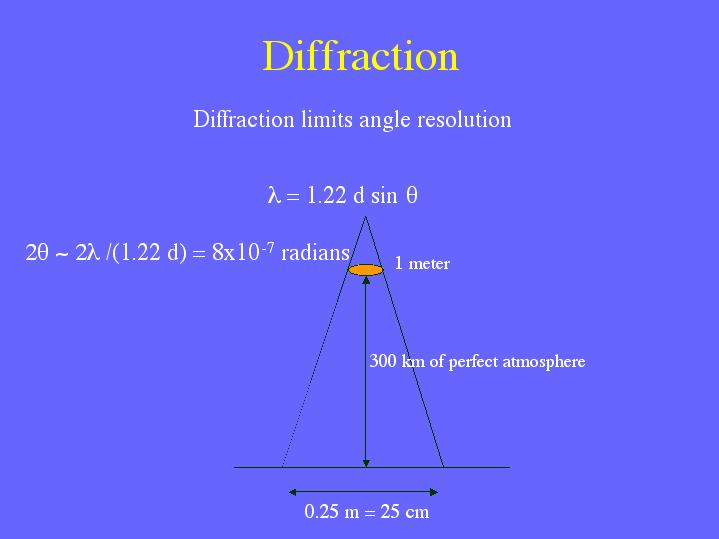

Diffraction gratings work because different wavelengths of light will constructively interfere at different angles.

Diffraction definition science series#
A diffraction grating can be a series of closely-spaced slits or a mirror with a series of small grooves. Uses of diffractionĭiffraction can be used to separate different wavelengths of light using a diffraction grating. The strongest examples of diffraction occur in waves where the wavelength is similar to the size of the object causing diffraction. You can easily demonstrate diffraction using a candle or a small bright flashlight bulb and a slit made with two pencils. (such as in single slit diffraction) How do they work together When light passed through the slits in a grating for example, it is diffracted.spreads out towards the screen. Light bends when it passes around an edge or through a slit. These patterns of interference rely on the size of the diffracting object and the size of the wave. Diffraction is the spreading of a wave due to it going through a gap (Aperture) or around a small object. When interference is destructive, the intensity will decrease, sometimes to a point where it is completely destroyed. When interference is constructive, the intensity of the wave will increase. Diffraction is most prominent when the wavelength is close to the aperture size UV waves have a wavelength between 4 × 10-7 1 × 10-8 m so wont be diffracted. The effect is that of the addition of the amplitudes of the individual waves at each point affected by more than one wave. Interference can be either constructive or destructive. Diffraction is the interference or bending of waves around the corners of an obstacle or through an aperture into the region of geometrical shadow of the. interference, in physics, the net effect of the combination of two or more wave trains moving on intersecting or coincident paths. This shift will cause the wave to have interference with itself. The wave that passed through the slits was diffracted and will interfere with itself.ĭiffraction is caused by one wave of light being shifted by a diffracting object. For a larger version of the image click here.A sketch of two-slit diffraction. Knowles, "Deformation twinning in commercial purity titanium at room temperature", Philosophical Magazine 95:20, 2153-2166 (2015).


This electron diffraction pattern has been image processed to highlight the -1 2 -1 4 and 1 -2 1 -4 twin spots, which have a low intensity because of their large | g|. (c) Electron diffraction pattern from (b) viewed down the zone ( in the three index notation) common to both the matrix and the twin confirming twinning on (-1 2 -1 4). Each unit-cell (dark lines) defined by a lattice parameter set a, b, c contains N atoms at. Put another way, it consists of a periodic (that is, oscillating or vibrating) variation of pressure occurring around the equilibrium pressure prevailing at a particular time and place. When a light wave or a sound wave encounters an object. Both light and sound transfer energy through waves. (b) Bright field image of the TEM specimen taken from the boxed region in (a). Schematic representation of a three-dimensional periodic crystal. A sound wave thus consists of alternating compressions and rarefactions, or regions of high pressure and low pressure, moving at a certain speed. Diffraction is the bending and spreading out of light or sound waves around an object. The loading direction is in the horizontal direction. X-rays offer a highly robust method for many aspects of structure analysis, from crystalline unit-cell parameters and atomic arrangements through to phase analysis and strain.Įlectron diffraction offers sub-nanometre spatial resolution allowing diffraction from individual nanostructures, secondary phases and similar inclusionsīanner image: (a) EBSD scan of an individual twins outlined in black. Diffraction definition: Change in the directions and intensities of a group of waves after passing by an obstacle or through an aperture whose size is approximately the same as the wavelength of the waves. The department is actively involved in crystallography using X-rays, neutrons and electrons, with extensive internal facilities allowing a range of X-ray and electron crystallographic measurements. A Physics definition of refraction involves a change in the direction of waves as they pass from one medium to another. Typically this is done by measuring the diffraction of radiation by the columns of atoms and planes of atoms in the crystal and then reconstructing the original atomic arrangement. This is one of the key analytical techniques in Materials Science as it is only with a clear understanding of the atomic structure that the properties of materials can be accurately described and understood. Crystallography is the study of the arrangement of atoms in materials.


 0 kommentar(er)
0 kommentar(er)
